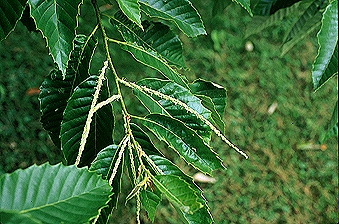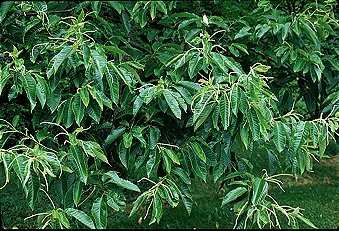Castanea dentata
 Habitat: Northern hardwood forests, meadows, edges, pastures. Often grown as an ornamental
tree because of its long feather-like flowers which appear in late spring and early summer.
Habitat: Northern hardwood forests, meadows, edges, pastures. Often grown as an ornamental
tree because of its long feather-like flowers which appear in late spring and early summer.
Characteristics: At one time these trees attained a height of 100 feet and the trunks were 2-4 feet in diameter; however, a ubiquitous fungus (Endothia parasitica ) precludes the normal growth of the tree. At present, most trees never grow taller than 25 feet.
Although it was formerly a dominant tree of the oak-chestnut forest, now only gray skeletons remain of this once majestic tree. A fungus disease which originated in eastern Asia was accidentally introduced into this country in 1904. By 1930, the disease had spread across the nation, killing just about all of our American chestnut trees. The few remaining trees growing today are root sprouts originating from the root systems of long-dead mature trees. Eventually the small trees contract the blight and die, too. However, as the older root sprouts die they are replaced by new shoots.
 The wood was light and not very strong but very durable. It had a variety of uses ranging from
furniture to railway ties. The chestnut was also one of our most beautiful ornamental trees and
produced large crops of flavorful nuts enjoyed by man and wildlife alike.
The wood was light and not very strong but very durable. It had a variety of uses ranging from
furniture to railway ties. The chestnut was also one of our most beautiful ornamental trees and
produced large crops of flavorful nuts enjoyed by man and wildlife alike.
![]()